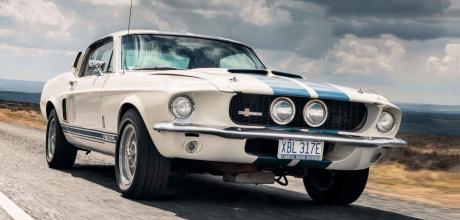1967 Shelby GT500
The GT500 took Carroll Shelby in a new direction. We drive a survivor to discover whether the Le Mans legend could build a luxury grand tourer. Words Emma Woodcock. Photography Jonathan Jacob.
Excess All Areas
The ultimate muscle car? Hitting the road in the Shelby GT500
Big, fat numbers, but is the GT500 muscle car or luxo-tourer?
Seven litres, four headlights – the 1967 GT500 is where race-bred go meets muscle car show, in an application that signalled Carroll Shelby’s new approach to road-car engineering.
Three pumps of the throttle prime the twin Holley carburettors that crown the 428 cubic-inch Police Interceptor V8 engine. I reach out to the aluminium dash and twist the key, squeezing gently down into the accelerator as the starter starts to churn with a messy, reluctant whinny. The V8 thunders into life, rocking the whole car on its springs as I let the revs rise and fall. Sickly sweet fuel vapours seep into the cabin – the two Holley 600CFM carburettors supply far more petrol than the engine can burn – and the GT500 settles to a slow, bassy idle that rattles the bonnet and pounds against my chest.
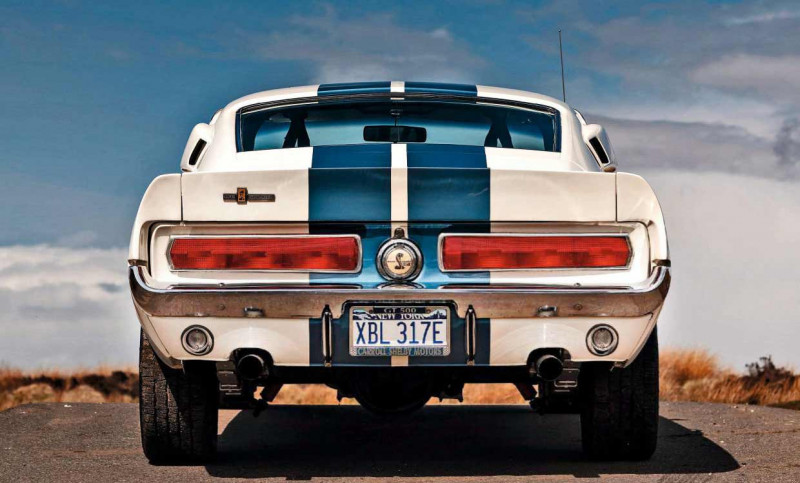
Of course, 1959 Le Mans-winner and AC Cobra creator Shelby had built Mustangs before, but those cars were lightweight circuit racers with barely enough civility to use on the public highway. With intensifying competition from the 427ci Chevrolet Corvette C2 and the Mopar 426 Hemi engine, the 4.7-litre V8 in the 1965 Shelby Mustang GT350 and 1966 Shelby GT350 lacked the power and displacement for all-American bragging rights too. Carroll’s customers wanted more, and the first-year GT500 was his response. It set the format for every Shelby Mustang since.
‘Now the Shelby gets the message. The body yaws back over the rear axle...’
Shelby shifted philosophy for the 1967 model year, stepping away from the hotrods that built his reputation as a manufacturer and embracing premium luxury. Styling had to stand apart from the standard Ford Mustang, so Carroll received Ford designers into his Shelby American team to reshape the bodywork and specified a full-height rollbar, inertia-reel shoulder harnesses and an Italian wooden steering wheel for the interior. Aiming to comfortably outpace the new 320HP Ford Mustang 390GT, the latest Shelby also gained its gigantic 428ci V8. Designed for law enforcement installations, the 7.0-litre unit was the first big-block that Shelby ever fitted to a production Mustang.
The mighty performance is only made possible by the 1967 Mustang redesign. Led by Lee Iacocca, Ford overhauled the pony car for its third year on sale to compete with the upcoming Chevrolet Camaro. The revised car was larger and the increased distance between the suspension towers allowed big-block engines to slot straight into the Mustang frame for the first time. Shelby American took immediate advantage of the extra space, using 1967 Mustang panels to wedge a 427 side-oiler competition engine into a 1965 GT350 body. The 428 GT350 prototype wasn’t pretty but it proved the concept. Shelby could build a faster Mustang. Chuck Cantwell, who’d previously engineered the 1965 GT350, was tasked with making it happen.
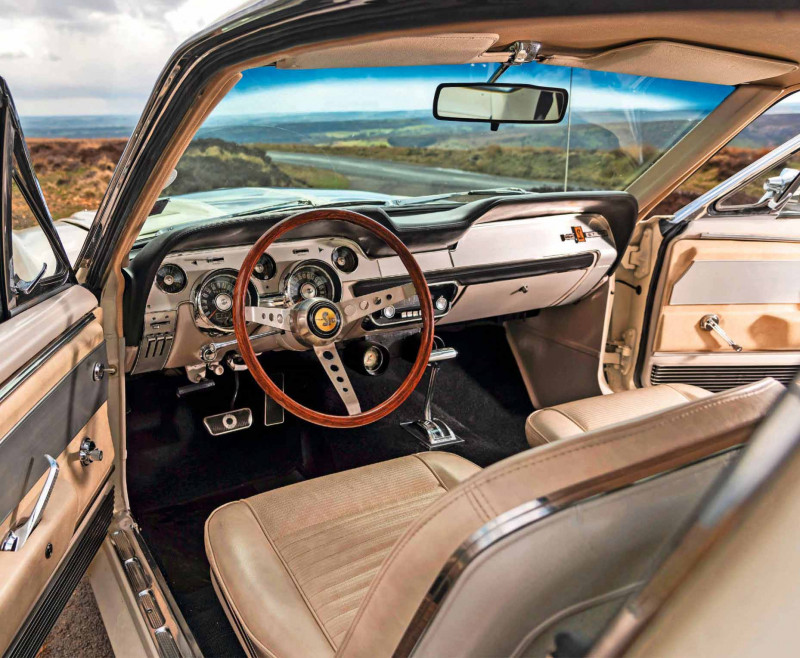
As I enter a dual carriageway, I grab my first chance to see how quick a production GT500 feels today. Creeping into the throttle releases a subtle surge that’s joined by a rounded exhaust bellow as the revs pass 2000rpm but not much more, so I kick harder to make it past the sticky detent halfway through the pedal travel. Now the Shelby gets the message. The body yaws back over the rear axle, the V8 drops a semi-octave and we pulse past inside-lane traffic.
Then the Cruise-O-Matic transmission kicks down into second and the 428 engine turns frantic. A rasping, dry holler shouts back from the engine bay and it only grows grittier and more metallic the longer I press the throttle. Contemporary reviews suggest an auto-equipped GT500 hits 60mph no quicker than a Dino 246GT, but the delivery of that performance could hardly be more different.
Equipped with a Ford aluminium intake and standard Mustang 390GT exhaust manifolds, the long-stroke engine turns 420lb ft at 3200rpm, ensuring that torque-rich acceleration is always available. Combined with this car’s three-speed automatic, it makes for relaxing progress over the knotted tarmac of North Yorkshire. Keen drivers could fit the Shelby with the standard four-speed manual gearbox and an optional limited-slip differential but the GT500 feels like a consummate cruiser without them. Though drive engages with a clunk from standstill, the torque converter helps the Shelby glide smoothly and eagerly up to third. It then remains in top gear wherever possible, lugging as low as 1500rpm unless I lean hard into the throttle to kick down.
‘The GT500 outsold the less extravagant GT350 at a rate of almost two to one
Burbling along at low revs gives me more time to appreciate the interior, which borrows the choicest entries of the 1967 Ford options list. The Mustang Deluxe package was fitted to almost all GT500s as standard – providing the aluminium dashboard inserts, courtesy lights and binnacle-mounted rev counter – as were the otherwise optional AM radio, Ford comfort weave front seats and foldable rear seats. For the first time in Shelby history customers could select a non-black interior too, with the introduction of Ford’s Parchment vinyl trim.
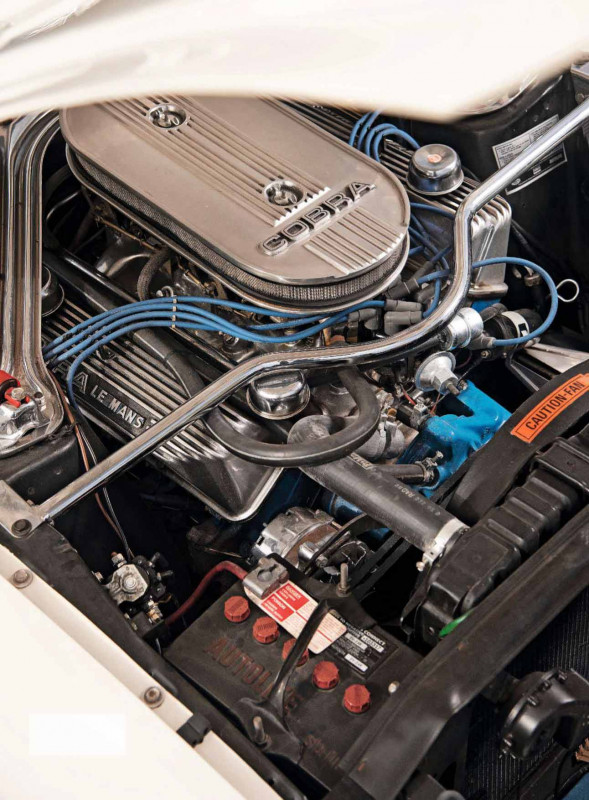
It’s a far cry from the spartan, two-seat 1965 GT350 cabin but Shelby American still found ways to differentiate the GT500 from standard production Mustangs. Coiled snake badging with a model-specific script peppers the dash, lapbelt release buttons and horn push, while the integral roll bar and front inertia-reel shoulder belts show a focus on safety that was decades ahead of American competitors. On the open road, though, the best addition is the one between my fingers. Crafted by Italian firm EFFPI, the smooth, deeply dished woodrim steering wheel is a constant reminder of the GT500’s luxurious aspirations.
Charlie McHose took responsibility for creating an equally distinctive exterior. Building on sketches made by a team of stylists at Ford’s Dearborn headquarters, he worked with clay model specialists Joe Farrer and Carl Nasson throughout early 1966 to create dramatic front and rear body sections made entirely from glassfibre. McHose used GT40 design cues to create the tunnel air vents over the quarter windows and the ducktail spoiler, establishing a firm link to Shelby’s contemporary Le Mans victory, while the group worked together to create a bonnet and front wings four inches longer than standard. Carroll approved and in August that year the GT500 entered production.
Construction was split between two sites, with most of the assembly completed at the Ford plant in San Jose, California – here a GT500 gained its 428 engine, 3.50:1 final drive and uprated running gear on the mainstream production line. Shelby American then took over to fit the glassfibre body panels and finishing touches. Despite trouble making the specialist parts align – McHose had unknowingly used a bent unibody as his styling buck – the company finished 2048 GT500s before the year was out. The 7.0-litre model had outsold the less potent and extravagant GT350 at a rate of almost two to one and contributed to Shelby’s most successful year to date.
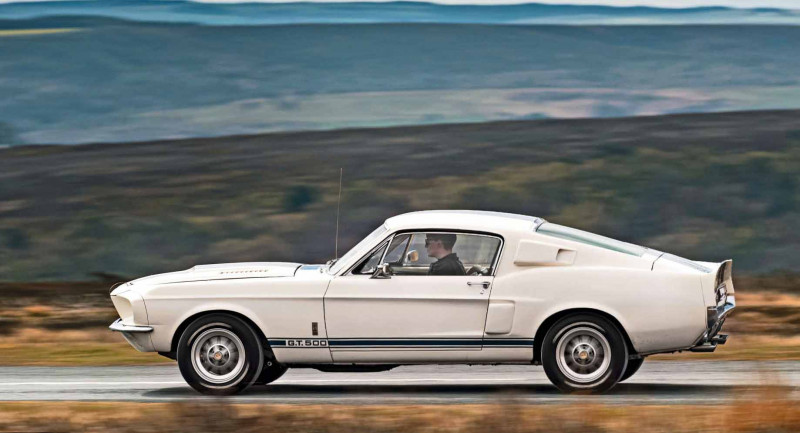
Ordered in April 1967 and constructed two months later, our test car is one of the final first-year machines. Like almost every GT500, the then-Nightmist Blue Shelby was also fitted with a range of mandatory cost extras that included power-assisted steering, power-assisted brakes and the shoulder harness seatbelts, adding $217.18 to this car’s $3440.70 basic invoice price. Shelby American even charged an extra $1.20 for the four gallons of petrol in the tank at handover.
The GT500 was delivered to Republic Ford Sales in Houston, Texas and quickly sold to a doctor in the nearby city of Katy. He kept the car for the next three years, before selling it to an enthusiast in the state capital of Austin. It changed hands again in 1977 but it wouldn’t leave the lone star state until 1988, when it took the long trip north to Pennsylvania. There it remained for the next 15 years, until a Texas firm exported the Mustang to the United Kingdom in 2003. The odometer showed just 50,000 miles. Over the next two years, the Shelby received a full restoration in the hands of its first British owner. The original 428 PI engine gained new pistons and rings, pushrods and bearings, while the body was stripped back to bare metal and repainted in Wimbledon White with twin blue Le Mans stripes.
After public appearances at Capel Manor and the 2007 MPH Show, the car passed through two further owners in the UK before arriving at Classic and Sportscar Centre in Malton, North Yorkshire, through which it was recently sold. ‘Everyone who visited our showroom wanted to talk about the GT500,’ they add. ‘There was a real buzz around the car.’
A 1965 or 1966 Shelby GT350 would fervently attack these bucks and twists of Blakey Ridge. The GT500 isn’t quite so keen. Weighing in at 1597kg, the 1967 range-topper is more than 300kg heavier than its predecessors and places 58% of its total mass over the front axle. Those figures align with Chevrolet’s Corvette Sting Ray and the Pontiac GTO, signalling the Shelby’s transformation into a luxurious muscle car cruiser.
The Mustang feels its weight on these roads, especially when I hit the brakes. Slowing from speed pitches the nose down and sends the front tyres squirrelling across the road, making the car ponderous and hard to trust. Despite standard 287mm discs with similar bite to the optional items on Camaros, Tempests and other Mustangs, the GT500 wasn’t built for British backroads and repeated applications see the power-assisted pedal get longer and lighter. Steady, progressive inputs create a smoother response.
Tight and cambered corners also demand a measured hand before the Shelby American upgrade package rewards. Fitted as standard with a Ford quick ratio steering box, the GT500 jumps to my initial inputs but the lack of feel through the power-assisted rim – a first for any Shelby Mustang – means it’s easy to add too much lock. Do that and the body starts to roll aggressively, before falling into understeer led by the hefty front end.
Waiting for the car to settle after the first part of a turn improves the experience. Now the Mustang leans into its thick sidewalls but goes no further, held in place by Ford heavy duty front coil springs and a Shelby-specific anti-roll bar that keep the car composed through fast, sweeping turns. There’s still minimal feedback coming through the light steering but the all-round Gabriel sports dampers provide a communicative if firm ride that sets the Shelby apart from other 1967 Mustangs.
The pogo-hopping harshness of the rear axle is more familiar, because the Shelby GT500 uses the same solid axle and semi-elliptic leaf spring combination as every classic Mustang. Though less sophisticated than the independent systems used by Jaguar’s E-type and the more expensive Chevrolet Corvette Sting Ray, it’s the same setup used by every four-seater muscle car that Shelby was trying to beat and – with the help of Shelby American rubber bump stops – the rear suspension squats predictably and controllably when accelerating in a straight line. Powering out of corners cleanly is more of a challenge though, the primitive suspension shaking the rear end up and down as it tries to counteract heavier loads.
With each curving mile, the message becomes clearer. The GT500 is no sports car – it’s a high-performance tourer. At a cruise the light controls, soft ride and low-revving 428 combine to cosset and relax me, safe in the knowledge that sledgehammer performance is just a pedal-press away. Buyers loved the combination, so Shelby built on the concept for his faster and more refined 1968 models. Sales rose again, then stayed in four figures in 1969. All across Detroit, performance cars followed the same more-is-more strategy. By 1970 the Chevrolet Chevelle rocked a 454ci (7440cc) big-block and the Pontiac GTO displaced some 455ci (7456cc).
The GT500 set the style for decades of Mustang performance models – including its current 760 horsepower namesake – but 1967 was also the end of an era. Production moved to an external contractor for 1968 and Ford took control of the Shelby models for 1969.
Never again would the range-topping Mustang be developed by a small team of enthusiasts working from a race shop at Los Angeles International airport. Thundering home over the Moors, both windows down and all four headlights ablaze, the Shelby GT500 proves its hybrid appeal in one final performance. It’s got the body of a peacock and the heart of an eagle.
TECHNICAL DATA 1967 Shelby GT500
- Engine 7014cc V8, hydraulic valve lifters, ohv, twin Holley 4150 four-choke 600 CFM carburettors
- Max Power 355bhp @ 5400rpm
- Max Torque 420lb ft @ 3200rpm
- Transmission Ford Cruise-O-Matic three-speed automatic, rear-wheel drive, optional limitedslip differential
- Steering Recirculating ball, power-assisted
- Suspension Front: independent, unequal arms, coil springs, Gabriel dampers, anti-roll bar. Rear: live axle, semi-elliptic leaf springs, rubber bump stops, Gabriel dampers
- Brakes Front: Ford discs. Rear: Ford drums. Twin servos and power assistance throughout
- Weight 1597kg
- Performance 0-60mph: 6.5sec;
- Top speed: 128mph
- Cost new $4395 (approx. £1575)
- CC Price Guide £90,000-£150,000
Collectors revere 1967 Shelbys because it was the final year that the cars were built at the Shelby American plant in Venice, California. Cooling vents in glassfibre bonnet are functional, and necessary. Front disc brakes behind wheels are standard fit Design team took inspiration from the GT40. Shelby’s modifications to the Police Interceptor V8 included new cylinder heads, exhaust manifolds, plus branded valve covers and air filter lid. Shelby sought to offer visual differentiators beyond those available to lesser Mustangs. Interior came in two colours – Parchment (seen here) or black. Lap belt complements shoulder harnesses top-mounted to the two-point rollbar The letters didn’t just represent a sporting link; this is indeed a grand tourer. GT500 was given Ford’s GT-level trim, including the woodrim wheel – additionally furnished with a Shelby-branded boss.
RESTORING A SHELBY GT500
Alan Faulkner-Stevens knows Shelby Mustangs like few others. He’s worked on the models for the last four decades and runs specialist American car workshop Dragon Wheels Restorations, focussing on Sixties and Seventies muscle cars. ‘The desirability of the best Shelby GT500s is in their originality,’ he explains. ‘In the past we used to tune these cars up, but the market has moved back towards period accuracy over the last 20 years. The Ford parts on a Shelby are all date-coded and any deviations from originality will have an impact on a car’s value. Even a respray in a colour that wasn’t original to the car can knock 15% off the price.
‘Original Shelby “take off” pieces like the carburettors and distributor are going up in value by about 25 percent each year. Availability is very restricted. The integral rollbar and inertia-reel seatbelts are especially hard to find, so you have to pay whatever the seller wants for them.
‘You can buy reproductions of any Ford Mustang component. Some are very good – like the wiring harness, seat trims and Shelby valve covers – but others aren’t quite right. New carpet sets aren’t as closely moulded as the originals and the recreated bulkhead insulation isn’t accurate.
‘Getting the structure right is the biggest challenge. The reproduction glassfibre panels aren’t quite correct, so those have to be reshaped, and fresh welding should be done to the period pattern. I’d be very concerned if all the panels on a purportedly original GT500 fitted properly! More information about the Shelby GT500 is always coming to light – I’d definitely advise against buying one blind.’


